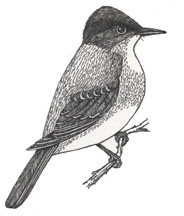

They winter from Mexico all the way up the eastern U.S. coast. In summer, they go north as far as the Yukon to breed.
They live in open woodlands near water. They like cliffs, bridges and buildings.
They are olive-gray with a darker head than back, solid black bill, and no wing bars or eye ring. They are 6 -7 inches long.
They wag their tails and have a “phoe-be” call.
They catch insects in flight.
They nest in a small cup made of mud, moss and leaves and lined with grass and hair. They cement their nests to a wall with mud, close to a ceiling under a bridge, cliff, or the eave of a building. The female lays 2 - 6 white, sometimes dotted, eggs.
Kingdom: Animalia
Phylum: Chordata
Subphylum: Vetebrata
Class: Aves
Order: Passeriformes
Suborder: Tyranni
Family: Tyrannidae
Genus: Sayornis
Species: S. phoebe
When you research information you must cite the reference. Citing for websites is different from citing from books, magazines and periodicals. The style of citing shown here is from the MLA Style Citations (Modern Language Association).
When citing a WEBSITE the general format is as follows.
Author Last Name, First Name(s). "Title: Subtitle of Part of Web Page, if appropriate." Title: Subtitle: Section of Page if appropriate. Sponsoring/Publishing Agency, If Given. Additional significant descriptive information. Date of Electronic Publication or other Date, such as Last Updated. Day Month Year of access < URL >.
Amsel, Sheri. "Phoebe (Eastern)" Exploring Nature Educational Resource ©2005-2024. December 13, 2024
< http://exploringnature.org/db/view/Phoebe-Eastern >

